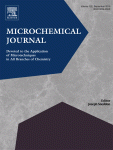Ver ítem
- xmlui.general.dspace_homeCentros Regionales y EEAsCentro Regional Chaco - FormosaEEA El ColoradoArtículos científicosxmlui.ArtifactBrowser.ItemViewer.trail
- Inicio
- Centros Regionales y EEAs
- Centro Regional Chaco - Formosa
- EEA El Colorado
- Artículos científicos
- Ver ítem
Direct analysis of néctar and floral volatile organic compounds in hybrid onions by HS-SPME/GC-MS: Relationship with pollination and seed production
Resumen
In this study, a simple and solvent-free method using headspace solid-phase microextraction (SPME) and gas chromatography–mass spectrometry (GC–MS) was developed for determination of the volatile compounds from fresh flowers and nectar of male sterile and fertile lines of Allium cepa L. The SPME parameters were studied; the optimum conditions of 85 μm carboxen/polydimethylsiloxane (CAR/PDMS), extraction temperature of 30 °C and extraction time of 30 min
[ver mas...]
In this study, a simple and solvent-free method using headspace solid-phase microextraction (SPME) and gas chromatography–mass spectrometry (GC–MS) was developed for determination of the volatile compounds from fresh flowers and nectar of male sterile and fertile lines of Allium cepa L. The SPME parameters were studied; the optimum conditions of 85 μm carboxen/polydimethylsiloxane (CAR/PDMS), extraction temperature of 30 °C and extraction time of 30 min were obtained. The analytical method was applied to characterize different onion lines according to the chemical composition of the volatile fraction of nectar and flowers. On the other hand, it was determined which odor components contribute to the pollination of onions lines and relate the content of specific analytes with foraging behavior and seed production. More than 90 compounds were identified. The samples studied showed differences in the volatile profiles of flowers and nectar among the different lines. The results demonstrated that headspace SPME–GCMS is a simple, rapid and solvent-free method suitable for analysis of volatile compounds emitted from onion plants. Furthermore, a great difference was found for the number of bee visits and seed yield among the onion lines analyzed. This study demonstrates that the combination
of chemical information and statistical analysis is able to differentiate onion male sterile lines from fertile lines, as well as among male sterile lines. Repellent compounds, such as dioxolanes, piperidines and
organosulfurs may contribute negatively to pollination, since the higher content of these analytes, the less bee visits and seed production yield.
[Cerrar]

Autor
Soto Vargas, Verónica Carolina;
Maldonado, Irma Beatriz;
Jofre, Viviana Patricia;
Galmarini, Claudio Romulo;
Silva, Maria Fernanda;
Fuente
Microchemical journal 122 : 110-118. (September 2015)
Fecha
2016
Formato
pdf
Tipo de documento
artículo
Palabras Claves
Derechos de acceso
Restringido
 Excepto donde se diga explicitamente, este item se publica bajo la siguiente descripción: Creative Commons Attribution-NonCommercial-ShareAlike 2.5 Unported (CC BY-NC-SA 2.5)
Excepto donde se diga explicitamente, este item se publica bajo la siguiente descripción: Creative Commons Attribution-NonCommercial-ShareAlike 2.5 Unported (CC BY-NC-SA 2.5)

